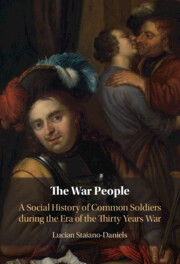Refine search
Actions for selected content:
15401 results in Military history

The War People
- A Social History of Common Soldiers during the Era of the Thirty Years War
-
- Published online:
- 19 December 2024
- Print publication:
- 19 December 2024
2 - The Italian Dance
- from Scene I - Hieronymus Sebastian Schutze and Hans Devil
-
- Book:
- The War People
- Published online:
- 19 December 2024
- Print publication:
- 19 December 2024, pp 24-40
-
- Chapter
- Export citation
5 - The Kind of People I Know You Will Like
- from Scene I - Hieronymus Sebastian Schutze and Hans Devil
-
- Book:
- The War People
- Published online:
- 19 December 2024
- Print publication:
- 19 December 2024, pp 77-97
-
- Chapter
- Export citation
Conclusion
-
- Book:
- The War People
- Published online:
- 19 December 2024
- Print publication:
- 19 December 2024, pp 191-199
-
- Chapter
- Export citation
Scene I - Hieronymus Sebastian Schutze and Hans Devil
-
- Book:
- The War People
- Published online:
- 19 December 2024
- Print publication:
- 19 December 2024, pp 21-134
-
- Chapter
- Export citation
Bibliography
-
- Book:
- The War People
- Published online:
- 19 December 2024
- Print publication:
- 19 December 2024, pp 200-219
-
- Chapter
- Export citation
4 - The Spinner-Lords of Saint Gallen
- from Scene I - Hieronymus Sebastian Schutze and Hans Devil
-
- Book:
- The War People
- Published online:
- 19 December 2024
- Print publication:
- 19 December 2024, pp 58-76
-
- Chapter
- Export citation
Figures
-
- Book:
- The War People
- Published online:
- 19 December 2024
- Print publication:
- 19 December 2024, pp ix-ix
-
- Chapter
- Export citation
Contents
-
- Book:
- The War People
- Published online:
- 19 December 2024
- Print publication:
- 19 December 2024, pp vii-viii
-
- Chapter
- Export citation
Epigraph
-
- Book:
- The War People
- Published online:
- 19 December 2024
- Print publication:
- 19 December 2024, pp v-vi
-
- Chapter
- Export citation
Notes on Money, Dates, Ranks, and Measurements
-
- Book:
- The War People
- Published online:
- 19 December 2024
- Print publication:
- 19 December 2024, pp xiii-xiv
-
- Chapter
- Export citation
Acknowledgments
-
- Book:
- The War People
- Published online:
- 19 December 2024
- Print publication:
- 19 December 2024, pp xi-xii
-
- Chapter
- Export citation
3 - Righteous Guys
- from Scene I - Hieronymus Sebastian Schutze and Hans Devil
-
- Book:
- The War People
- Published online:
- 19 December 2024
- Print publication:
- 19 December 2024, pp 41-57
-
- Chapter
- Export citation
Tables
-
- Book:
- The War People
- Published online:
- 19 December 2024
- Print publication:
- 19 December 2024, pp x-x
-
- Chapter
- Export citation
6 - Elizabeth Sanner and the Dead Men
- from Scene I - Hieronymus Sebastian Schutze and Hans Devil
-
- Book:
- The War People
- Published online:
- 19 December 2024
- Print publication:
- 19 December 2024, pp 98-117
-
- Chapter
- Export citation
8 - Making It in This Thing
- from Scene II - Hieronymus Sebastian Schutze, Felix Steter, and Wolfgang Winkelmann
-
- Book:
- The War People
- Published online:
- 19 December 2024
- Print publication:
- 19 December 2024, pp 146-163
-
- Chapter
- Export citation
Copyright page
-
- Book:
- The War People
- Published online:
- 19 December 2024
- Print publication:
- 19 December 2024, pp iv-iv
-
- Chapter
- Export citation
9 - And to My Son the Breaking Wheel
- from Scene II - Hieronymus Sebastian Schutze, Felix Steter, and Wolfgang Winkelmann
-
- Book:
- The War People
- Published online:
- 19 December 2024
- Print publication:
- 19 December 2024, pp 164-190
-
- Chapter
- Export citation
Index
-
- Book:
- The War People
- Published online:
- 19 December 2024
- Print publication:
- 19 December 2024, pp 220-228
-
- Chapter
- Export citation
Scene II - Hieronymus Sebastian Schutze, Felix Steter, and Wolfgang Winkelmann
-
- Book:
- The War People
- Published online:
- 19 December 2024
- Print publication:
- 19 December 2024, pp 135-190
-
- Chapter
- Export citation
